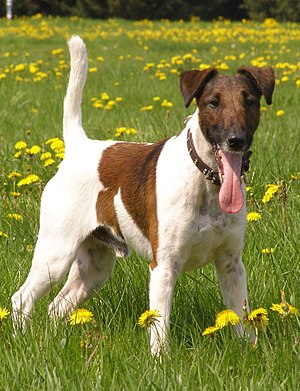Fox terrier
| Fox terrier | |||||
|---|---|---|---|---|---|
|
|||||
|
FCI standard No. 12 smooth hair 169 wire hair |
|||||
|
|||||
| Origin : | |||||
| Alternative names: |
Wirehaired hair: Wire-haired / Wire-haired |
||||
| Withers height: |
|
||||
| Weight: |
|
||||
| List of domestic dogs | |||||
Under Fox leads FCI two recognized British breeds ( FCI Group 3, Section 1, Standard Nos. 12 and 169 ).
Origin and history
The fox terrier probably originated in the 19th century, the original breeds involved are controversial in literature. The Kennel Club has registered the Fox Terrier (that's the English name) since 1876. Today, both the Kennel Club and the FCI differentiate between two breeds: the smooth-haired fox terrier and the wire-haired fox terrier.
Dogs, considered the forerunners of the breeds, emerged with the beginnings of fox hunting in England and were used as hounds in packs as well as for construction hunts . They were depicted on hunting pictures in the 14th and 15th centuries. The fox terrier was first exhibited in Birmingham in 1862 . Its breeding standard was set in 1876. It was introduced to Germany in the 1880s and further bred by Prince Albrecht zu Solms-Braunfels .
The origins of the Wirehaired Fox Terrier and the Smooth Haired Fox Terrier are the same, but the wire-haired breed is likely to be traced back to a cross between the smooth-haired fox and the wire-haired English terrier, so the smooth-haired fox is the older breed. In 1913 after the founding of the Wire Fox Terrier Association and the legalization of trimming , there was a strong upswing in the breeding of the wirehaired fox terrier.
description
Both races differ little: bone structure and colors are the same. The fox terrier grows up to 39 cm and weighs around 8 kg. Its fur is white with black markings or black and tan. The ears are small, V-shaped, kinked, with a neat fold falling forward close to the cheeks.
The coat of the straight hair is smooth, close-fitting and soft, that of the wire hair is dense and very wiry. The wirehaired fox terrier must be trimmed regularly (not sheared), otherwise the dense undercoat prevents the top hair from growing back, which leads to a loss of pigment in the top hair. This can be recognized by the reddish color.
use
Both breeds of dogs are ideal for hunting , especially fox and badger to wild boar hunting. They are very good companion dogs , but because of their liveliness and their "own head" they need consistent training and plenty of exercise.
breed
When breeding the fox terriers, two breeds are bred, the wire-haired and smooth-haired fox terrier. In the USA, both breeds are also bred as toy breeds ( i.e. with small shoulder height), which is not desirable in Europe.
Special diseases
Fox terriers are predisposed to ataxia and myelopathy in terriers and to congenital ectopic ureter .
Trivia
Struppi from the Tintin and Struppi comic strip is a white wire-haired fox terrier.
Individual evidence
- ↑ www.foxterrier-verband.de
- ↑ a b Hans-Joachim Swarovsky: BI-Lexicon dog breeds . 2nd Edition. VEB Bibliographisches Institut, Leipzig 1985, p. 170 .

